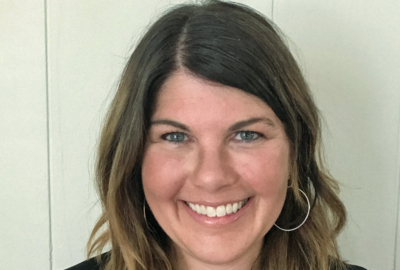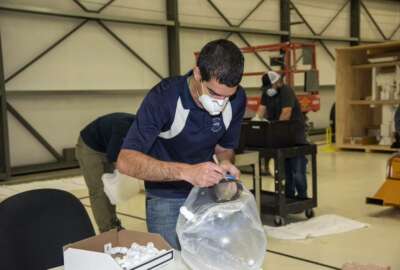
Joining the coronavirus response as a hobby
GPO IT specialist David Thibodeau not only 3D printed face shields and other small items for hospital employees, he built the 3D printer to make them.
Best listening experience is on Chrome, Firefox or Safari. Subscribe to Federal Drive’s daily audio interviews on Apple Podcasts or PodcastOne.
Some items in the battle against coronavirus are big. Navy ships, convention centers, sports arenas. Some are small, like face shields. That’s where our next guest comes in. He’s not only 3D printed face shields and other small items for hospital employees, he built the 3D printer to make them. To discuss, Government Publishing Office IT specialist David Thibodeau joined Federal Drive with Tom Temin.
Interview transcript:
Tom Temin: David, good to have you on.
David Thibodeau: Good to be here Tom.
Tom Temin: First of all, let’s start with you built your own 3D printer, is this something like a heathkit? Or how do you do that in the first place?
David Thibodeau: Yeah, it was a kit, I ordered the kit in full and put it together.
Tom Temin: All right, and what are some of the things you’ve been making?
David Thibodeau: So I got this printer shortly before we went on the lockdown so I haven’t really printed much other than the sample files before I got in touch with the hospital. But I printed you know, a couple pen holders, just some little statues to put on the bookshelf and things like that.
Tom Temin: But you are connected to a hospital now, tell us about that.
David Thibodeau: So I reached out to Holy Cross Germantown hospital in the middle of March. I got in contact with a doctor on April 1, he sent me a picture of the face shields and asked me if I could do anything like that. And so I found the parts online and start printing them out.
Tom Temin: And when you say you found the parts online, did you find a file that you could use in the printer?
David Thibodeau: So yeah, and actually the place where I purchased the 3D printer from they took an effort and kind of mobilize their community of people who, you know, they knew would have 3D printers. So at the same time, I was speaking with the doctor, I was getting emails from this company called Prusa and they were offering guidance on how we can use our 3D printers at home to help our communities and they actually put together a place online where their user base came together and designed the face shields that I’m printing out now.
Tom Temin: Now face shields have to be clear, right? So what materials do you print them from?
David Thibodeau: So the material that I’m printing from is actually, you know, the, the printed parts of the shield are the frame of the shield. And the clear part is an 8 and a half by 11 transparency sheet. I purchased some of those as well and they just attached to the frame.
Tom Temin: They still make transparency sheets, I guess? I didn’t that anyone still used them.
David Thibodeau: Yeah it’s amazing huh.
Tom Temin: So the part that sticks on your head that holds the shield, that’s a crescent shaped type of thing, and I mean, how big is it and what’s it made of?
David Thibodeau: It’s made of a material called PLA, which is polylactic acid and that is a thermal plastic that liquefies at around 200 degrees celsius so the printer melted down the positive layer by layer to a shield. The shield itself, I haven’t measured it, but let’s say it’s about as wide as someone’s head and about half as long.
Tom Temin: That makes sense. And how long does it take for one of these to come out?
David Thibodeau: So I actually print them out in batches of six. And what it’ll do is it’ll print two of them stacked on top of each other. And then the printer will run through some motions and knock it off into a box. And then it’ll start another stack of two and it’ll do this loop three times in about 16 hours. So it takes about 16 hours, and then I wind up with six shields. Also I print headbands for them as well.
Tom Temin: So it’s not exactly like producing them on moss in China say.
David Thibodeau: Oh, no, no, no, it’s, it’s, it’s time consuming. It’s not a very, very fast process at all.
Tom Temin: And so you have shipped these to the hospital and they’re using them?
David Thibodeau: I’m actually driving them over to the hospital. And they’re using them. My plan was at first to do them on Mondays and Fridays, but I’m producing them faster than I thought. So I’m going to be delivering Mondays, Wednesdays and Fridays now.
Tom Temin: And tell us more about what you do at the GPO. You’re an IT specialist. I know that used to be the Government Printing Office, but it wasn’t the government 3D printing office.
David Thibodeau: No, no. It’s the Government Publishing Office now. I’m an IT specialist there. I’m a systems administrator. I do a lot of the back end work with maintenance upkeep and implementing new technologies.
Tom Temin: Got it. So can you do this type of work from your home in the meantime?
David Thibodeau: Oh, yeah. It’s been very busy doing it in fact, printing at night.
Tom Temin: Well, I guess the printer is kind of runs in the background once you set it up to go. Any other parts besides face shield holders?
David Thibodeau: Yeah, I’m also printing out the tension release straps. You may have seen those online. It’s a strap that goes on the back of the head that attaches to the rubber band of facemask or anything that healthcare worker will put on their face with a rubber band that takes the tension from the band away from behind their ears, spreads it across the back of the head.
Tom Temin: Got it. And those are also the same type of thermoplastic deposition type of process?
David Thibodeau: That’s correct. And I’m bringing over those that rate about two to one for every shield because one they use these with the shields. And two these can also be used with masks for other things.
Tom Temin: If you don’t mind telling us, do you have family at home with you? Spouse, significant other? What’s your situation?
David Thibodeau: Yeah, it’s my wife and I, our cat and our two birds.
Tom Temin: Oh, yeah. So you don’t have to worry about homeschooling you were doing that with the cat and the birds and way.
David Thibodeau: No none of that. I’ve had a lot more time I’ve been able to put into other things.
Tom Temin: David Thibodeau is an Information Technology Specialist at the Government Publishing Office. Thanks so much for joining me.
David Thibodeau: Thank you, Tom.
Copyright © 2025 Federal News Network. All rights reserved. This website is not intended for users located within the European Economic Area.
Tom Temin is host of the Federal Drive and has been providing insight on federal technology and management issues for more than 30 years.
Follow @tteminWFED
Related Stories





